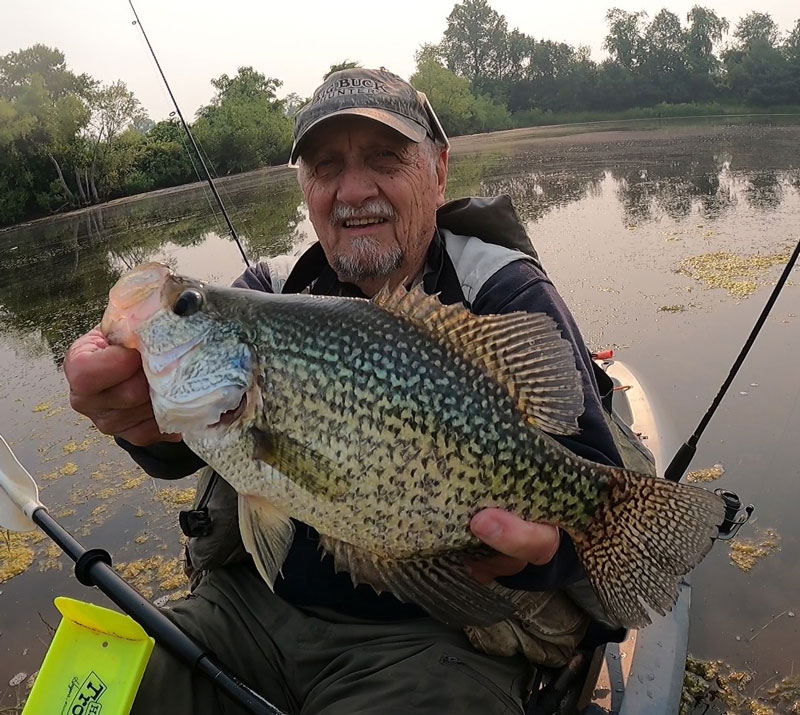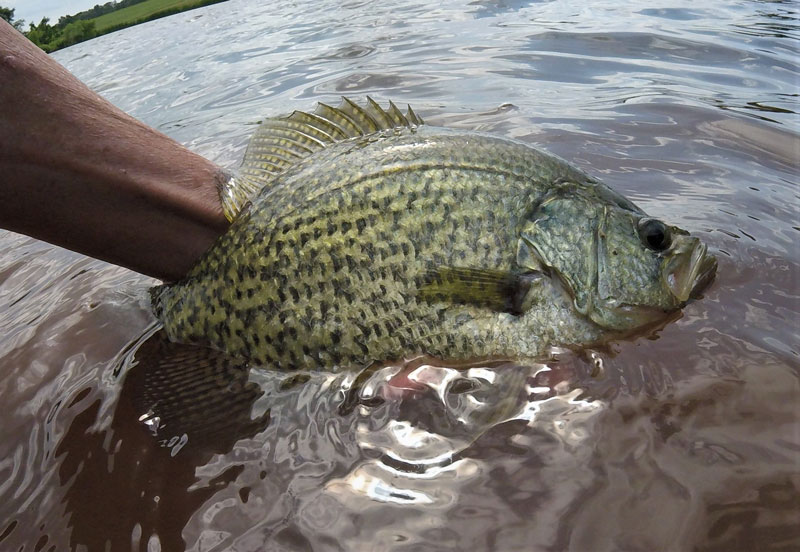Spring crappie fishing is a glorious thing — meaty slabs that taste great, bobbers going under, and the tug of a big panfish coupled with the joys of family fishing. Great times, great memories. But what happens after all those fish have completed spawning and vacated the shallows? Is crappie fishing over with until the cooler weather of the fall? Do we have to go slab-less all summer long?

Not at all. As a matter of truth, post-spawn crappie action can be hectic and dependable fishing. Indeed, the spawn is over, fry has hatched, and the fish’s habits have changed a bit. But don’t let the lack of shallow fish discourage you. Here is a plan of attack for crappie fishing once the spawn is over.
Post-Spawn Crappie Depth
Depending on the water you fish, crappies almost assuredly will seek deeper, cooler waters, along with structure, that will make their lives easier. Deep can be relative, and eight feet in a small farm or mill pond can be comparable to 20 feet in a larger reservoir. Brush piles, fallen logs, and deeper weed edges often are the home waters for late spring and summer crappies once their spawning chores are done. However, immediately after the spawn, crappies tend to take a period of time for recovery, especially the larger, adult male fish that are so important in protecting and nurturing the newly hatched offspring. If the tattered, worn-out males are absent from the shallows you fished last week then give the fish 10 days or more to settle into a post-spawn protocol.
Marina docks in tidal areas are crappie magnets, as are bridge pilings and overpasses that can offer both shade and deflection of current. Pay attention to the tidal flows and put your jigs in non-current areas as the tides shift. Also, pay attention to the shade-line of bridges and underneath piers where dock-shooting tactics can get your jigs way back underneath the boards and in where the fish are. Deeper weed beds in the 10- to-14-foot depth range are sometimes sweet spots for crappies, too, provided larger gamefish like pickerel or bass don’t spook them out. And on those shallow mill ponds of Delmarva don’t be afraid to fish a single, isolated piece of structure like a solitary log as it could hold a few big fish in a relatively barren expanse of water. Check out emerging lily pad fields, too, with a bobber and jig/minnow option.
Timing Crappie Fishing
In many bodies of water post-spawn crappies develop a nocturnal trend and feed primarily during dusk, dawn, or even during night. Established lighting on docks and marinas can draw nighttime crappies as insects and minnow activity pick up and trigger a bite. Late evening and dawn are also cooler and productive.

Some of our best crappie fishing for larger 12- to 14-inch fish are during the dawn’s early light. We like to use small crank baits like Rapala Count Down #5s in baby bass and shad patterns. Casting them on four-pound line, you can make long throws to a variety of structures and fish these slowly. Stikes often are heavy, abrupt thumps. If you’re casting these lures in and around woody structures, then heavier lines like 10-pound braid may be needed to wrestle a 14-inch slab from the wood. We like to use an eight or 10-pound leader of mono or fluorocarbon and attach the lure with a small cross-lock snap.
As always, it pays to be familiar with your waters prior to fishing at night or under low-light conditions. Scout ahead if necessary and be aware of your surroundings and any other boating activity that may be in the area.
Kayak Fishing for Crappie
Many of the lakes and small venues where you’ll find these fish offer excellent kayak or small boat fishing for crappies and some of our best catches have been made in these. Sometimes, a quality lake does not have a ramp or access for larger craft and that’s when the kayak gig can save the day for crappies after the spawn. This is especially true for those smaller tidal creeks and Eastern Shore millponds that are only seven to 10 feet deep.
Once the algae and weed growth comes on many fish relate to the deepest water near the pond’s dam face and other shaded or deeper channels, if they exist. Again, any fallen wood can hold fish as well and if the tree has plummeted into deeper water so much the better.
Some public and private venues have aerators, and these often attract large schools of suspended crappies. They provide oxygen, disoriented prey, and sometimes cooler water. A simple bobber/jig combo will often catch plenty of crappie along with other species such as bass and bluegill. As they are mid-lake, a kayak is as easy and stealthy as it gets for cruising up on these panfish attractors and quietly catching fish.
About suspended crappies: they will do exactly that, suspend, and sometimes large concentrations of fish can be right out in open water areas in great number. You’ll see this in larger water bodies as they calmly swim from one area of the lake or cove to another in search of baitfish or even insect hatches in the late spring or early summer. You can utilize either drifting, trolling, or sonar to locate schools of suspended fish.
Tackling the Tackle
For about 80-percent of our post-spawn crappie forays we use either a 1/16th or a 1/32nd ounce jig head with a two-inch plastic of some sort. In recent years, we have leaned on finesse baits and the Mule Jig durable baits for the bulk of this fishing. You can fish these super stretchy plastics in either the Mule Jig heads (1/32nd and 1/48th ounce) or the 1/15th and 1/20th ounce jig heads. We fish these either below a bobber or by simply casting them on light mono. An ultralight spinning set up that feels comfortable to you is the weapon of choice and longer casts are often a plus, especially if you encounter spooky fish or clear water conditions. As mentioned earlier, small crank baits can be the bomb when crappie get tired of all those plastic options, or you need to go deeper.
Don’t let post-spawn crappies give you the run around. Hit your favorite lake for fun and fillets!